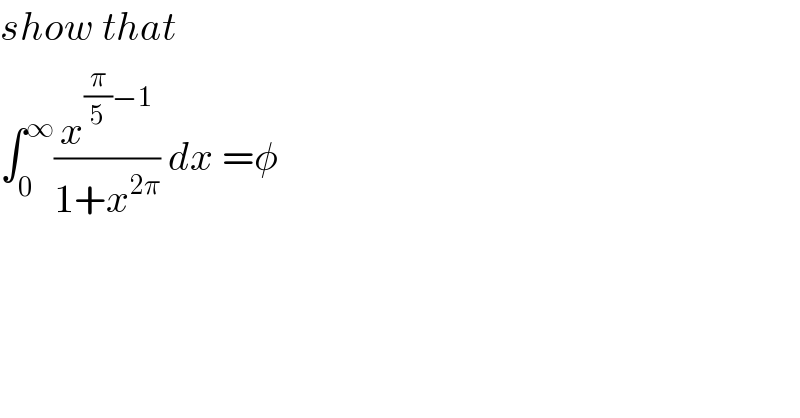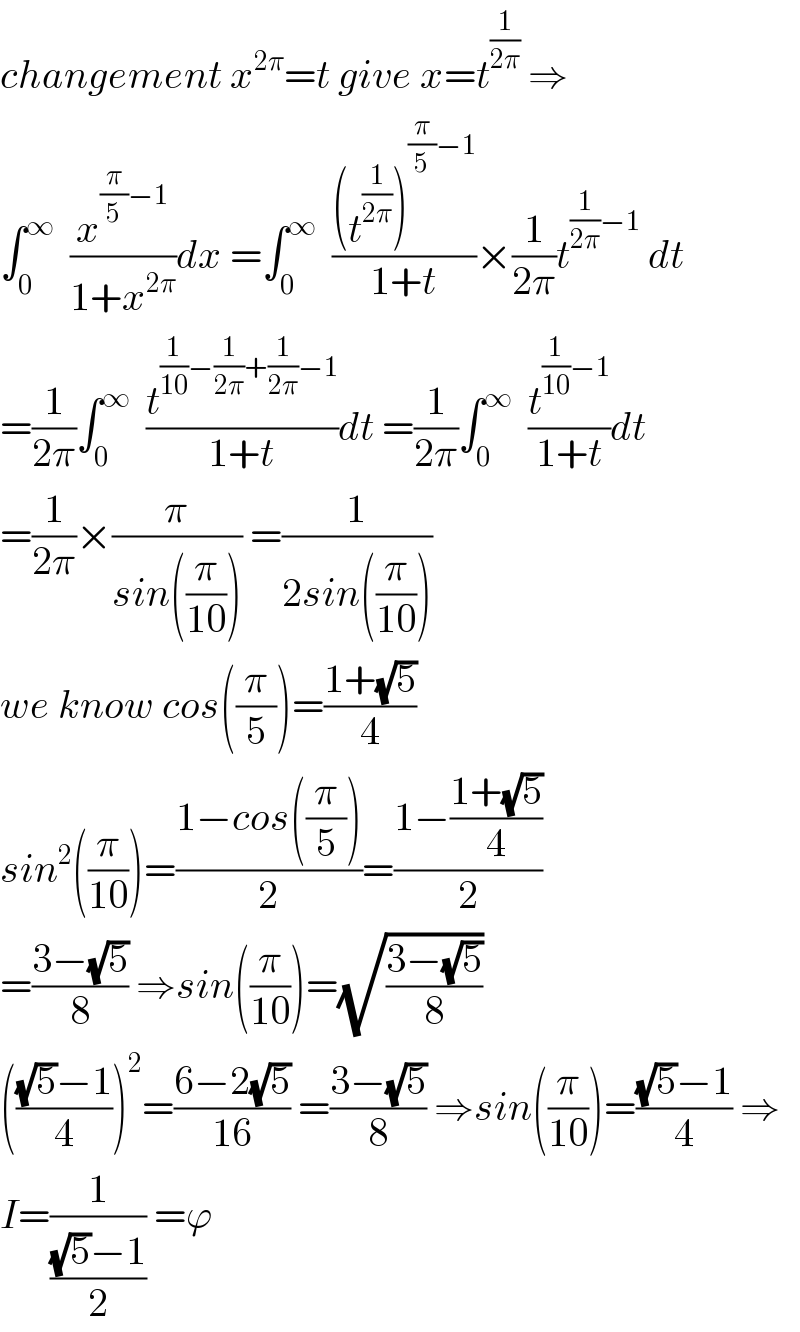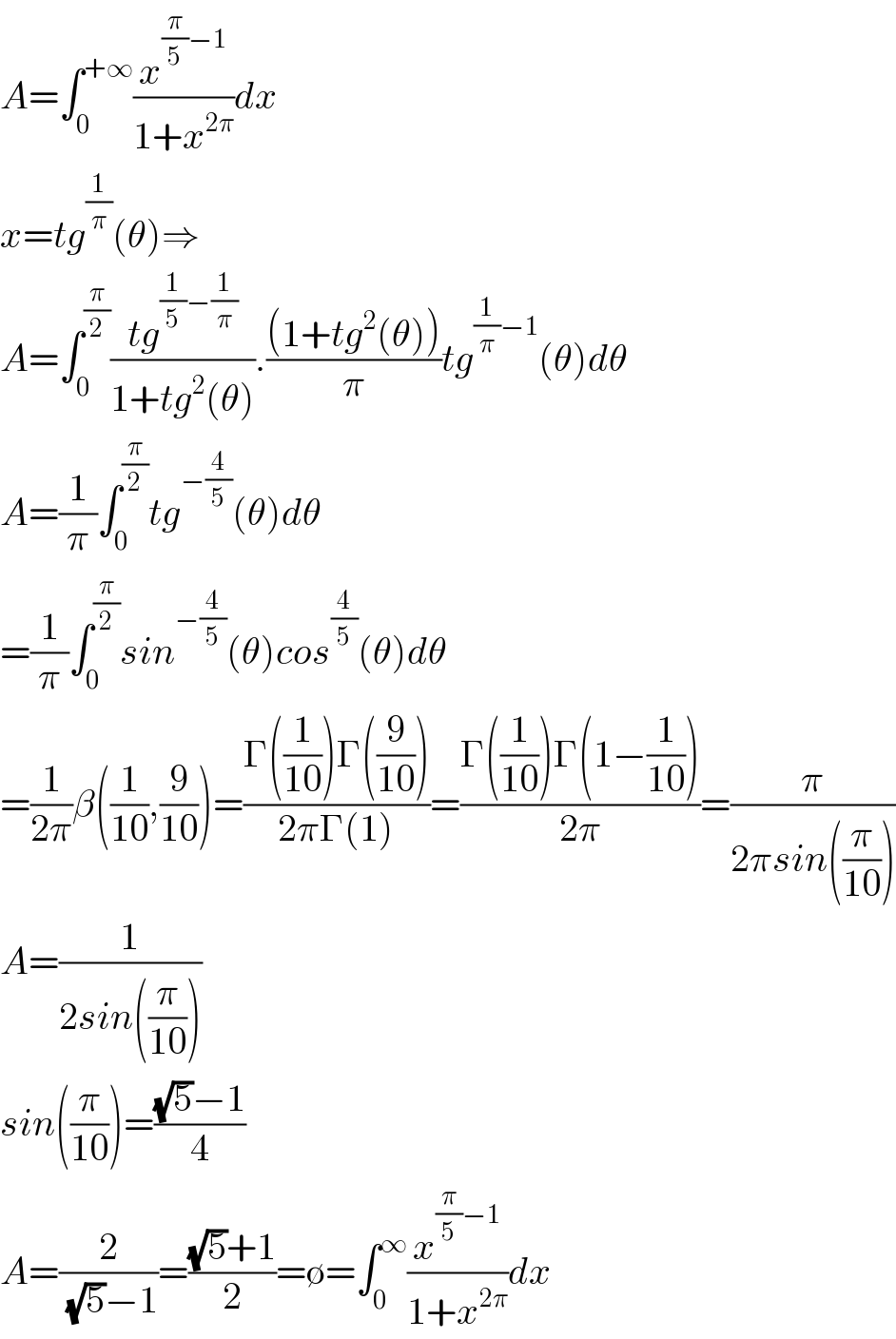
Question Number 80924 by M±th+et£s last updated on 08/Feb/20

$${show}\:{that} \\ $$$$\int_{\mathrm{0}} ^{\infty} \frac{{x}^{\frac{\pi}{\mathrm{5}}−\mathrm{1}} }{\mathrm{1}+{x}^{\mathrm{2}\pi} }\:{dx}\:=\phi\: \\ $$
Commented by abdomathmax last updated on 09/Feb/20

$${changement}\:{x}^{\mathrm{2}\pi} ={t}\:{give}\:{x}={t}^{\frac{\mathrm{1}}{\mathrm{2}\pi}} \:\Rightarrow \\ $$$$\int_{\mathrm{0}} ^{\infty} \:\:\frac{{x}^{\frac{\pi}{\mathrm{5}}−\mathrm{1}} }{\mathrm{1}+{x}^{\mathrm{2}\pi} }{dx}\:=\int_{\mathrm{0}} ^{\infty} \:\:\frac{\left({t}^{\frac{\mathrm{1}}{\mathrm{2}\pi}} \right)^{\frac{\pi}{\mathrm{5}}−\mathrm{1}} }{\mathrm{1}+{t}}×\frac{\mathrm{1}}{\mathrm{2}\pi}{t}^{\frac{\mathrm{1}}{\mathrm{2}\pi}−\mathrm{1}} \:{dt} \\ $$$$=\frac{\mathrm{1}}{\mathrm{2}\pi}\int_{\mathrm{0}} ^{\infty} \:\:\frac{{t}^{\frac{\mathrm{1}}{\mathrm{10}}−\frac{\mathrm{1}}{\mathrm{2}\pi}+\frac{\mathrm{1}}{\mathrm{2}\pi}−\mathrm{1}} }{\mathrm{1}+{t}}{dt}\:=\frac{\mathrm{1}}{\mathrm{2}\pi}\int_{\mathrm{0}} ^{\infty} \:\:\frac{{t}^{\frac{\mathrm{1}}{\mathrm{10}}−\mathrm{1}} }{\mathrm{1}+{t}}{dt} \\ $$$$=\frac{\mathrm{1}}{\mathrm{2}\pi}×\frac{\pi}{{sin}\left(\frac{\pi}{\mathrm{10}}\right)}\:=\frac{\mathrm{1}}{\mathrm{2}{sin}\left(\frac{\pi}{\mathrm{10}}\right)} \\ $$$${we}\:{know}\:{cos}\left(\frac{\pi}{\mathrm{5}}\right)=\frac{\mathrm{1}+\sqrt{\mathrm{5}}}{\mathrm{4}} \\ $$$${sin}^{\mathrm{2}} \left(\frac{\pi}{\mathrm{10}}\right)=\frac{\mathrm{1}−{cos}\left(\frac{\pi}{\mathrm{5}}\right)}{\mathrm{2}}=\frac{\mathrm{1}−\frac{\mathrm{1}+\sqrt{\mathrm{5}}}{\mathrm{4}}}{\mathrm{2}} \\ $$$$=\frac{\mathrm{3}−\sqrt{\mathrm{5}}}{\mathrm{8}}\:\Rightarrow{sin}\left(\frac{\pi}{\mathrm{10}}\right)=\sqrt{\frac{\mathrm{3}−\sqrt{\mathrm{5}}}{\mathrm{8}}} \\ $$$$\left(\frac{\sqrt{\mathrm{5}}−\mathrm{1}}{\mathrm{4}}\right)^{\mathrm{2}} =\frac{\mathrm{6}−\mathrm{2}\sqrt{\mathrm{5}}}{\mathrm{16}}\:=\frac{\mathrm{3}−\sqrt{\mathrm{5}}}{\mathrm{8}}\:\Rightarrow{sin}\left(\frac{\pi}{\mathrm{10}}\right)=\frac{\sqrt{\mathrm{5}}−\mathrm{1}}{\mathrm{4}}\:\Rightarrow \\ $$$${I}=\frac{\mathrm{1}}{\frac{\sqrt{\mathrm{5}}−\mathrm{1}}{\mathrm{2}}}\:=\varphi \\ $$
Commented by M±th+et£s last updated on 09/Feb/20

$${god}\:{bless}\:{you}\:{sir} \\ $$
Commented by mathmax by abdo last updated on 10/Feb/20

$${you}\:{are}\:{welvome}\:{sir}. \\ $$
Answered by mind is power last updated on 09/Feb/20

$${A}=\int_{\mathrm{0}} ^{+\infty} \frac{{x}^{\frac{\pi}{\mathrm{5}}−\mathrm{1}} }{\mathrm{1}+{x}^{\mathrm{2}\pi} }{dx} \\ $$$${x}={tg}^{\frac{\mathrm{1}}{\pi}} \left(\theta\right)\Rightarrow \\ $$$${A}=\int_{\mathrm{0}} ^{\frac{\pi}{\mathrm{2}}} \frac{{tg}^{\frac{\mathrm{1}}{\mathrm{5}}−\frac{\mathrm{1}}{\pi}} }{\mathrm{1}+{tg}^{\mathrm{2}} \left(\theta\right)}.\frac{\left(\mathrm{1}+{tg}^{\mathrm{2}} \left(\theta\right)\right)}{\pi}{tg}^{\frac{\mathrm{1}}{\pi}−\mathrm{1}} \left(\theta\right){d}\theta \\ $$$${A}=\frac{\mathrm{1}}{\pi}\int_{\mathrm{0}} ^{\frac{\pi}{\mathrm{2}}} {tg}^{−\frac{\mathrm{4}}{\mathrm{5}}} \left(\theta\right){d}\theta \\ $$$$=\frac{\mathrm{1}}{\pi}\int_{\mathrm{0}} ^{\frac{\pi}{\mathrm{2}}} {sin}^{−\frac{\mathrm{4}}{\mathrm{5}}} \left(\theta\right){cos}^{\frac{\mathrm{4}}{\mathrm{5}}} \left(\theta\right){d}\theta \\ $$$$=\frac{\mathrm{1}}{\mathrm{2}\pi}\beta\left(\frac{\mathrm{1}}{\mathrm{10}},\frac{\mathrm{9}}{\mathrm{10}}\right)=\frac{\Gamma\left(\frac{\mathrm{1}}{\mathrm{10}}\right)\Gamma\left(\frac{\mathrm{9}}{\mathrm{10}}\right)}{\mathrm{2}\pi\Gamma\left(\mathrm{1}\right)}=\frac{\Gamma\left(\frac{\mathrm{1}}{\mathrm{10}}\right)\Gamma\left(\mathrm{1}−\frac{\mathrm{1}}{\mathrm{10}}\right)}{\mathrm{2}\pi}=\frac{\pi}{\mathrm{2}\pi{sin}\left(\frac{\pi}{\mathrm{10}}\right)} \\ $$$${A}=\frac{\mathrm{1}}{\mathrm{2}{sin}\left(\frac{\pi}{\mathrm{10}}\right)} \\ $$$${sin}\left(\frac{\pi}{\mathrm{10}}\right)=\frac{\sqrt{\mathrm{5}}−\mathrm{1}}{\mathrm{4}} \\ $$$${A}=\frac{\mathrm{2}}{\sqrt{\mathrm{5}}−\mathrm{1}}=\frac{\sqrt{\mathrm{5}}+\mathrm{1}}{\mathrm{2}}=\emptyset=\int_{\mathrm{0}} ^{\infty} \frac{{x}^{\frac{\pi}{\mathrm{5}}−\mathrm{1}} }{\mathrm{1}+{x}^{\mathrm{2}\pi} }{dx} \\ $$
Commented by M±th+et£s last updated on 09/Feb/20

$${great}\:{sir}\:{thank}\:{you} \\ $$
Commented by mind is power last updated on 09/Feb/20

$${Withe}\:{pleasur}\:\:{have}\:{you}\:{somm}\:{Quation} \\ $$$${about}\:{hypergeometric}\:{Function}\:? \\ $$
Commented by M±th+et£s last updated on 09/Feb/20

$${yes}\:{i}\:{have}\:{this}\:{is}\:{an}\:{example} \\ $$$$\int\sqrt{{x}^{\mathrm{3}} +\mathrm{1}}\:{dx}=−{x}\:_{\mathrm{2}} {F}_{\mathrm{1}} \left(\frac{−\mathrm{1}}{\mathrm{2}}\:,\:\frac{\mathrm{1}}{\mathrm{3}};\frac{\mathrm{4}}{\mathrm{3}},−{x}^{\mathrm{3}} \right)+{c} \\ $$
Commented by M±th+et£s last updated on 09/Feb/20

$${i}\:{need}\:{some}\:{time}\:{to}\:{post}\:{all}\:{of}\:{my}\:{equations} \\ $$
